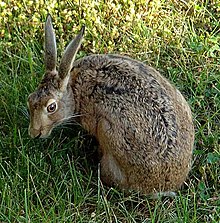European hare
| European Hare[1] | |
|---|---|

| |
| Scientific classification | |
| Kingdom: | |
| Phylum: | |
| Class: | |
| Order: | |
| Family: | |
| Genus: | |
| Species: | L. europaeus
|
| Binomial name | |
| Lepus europaeus Pallas, 1778
| |
The European Hare or Brown Hare (Lepus europaeus) is a species of hare native to northern, central, and western Europe and western Asia.
It is a mammal adapted to temperate open country. It is related to the similarly appearing rabbit, which is in the same family but a different genus. It breeds on the ground rather than in a burrow and relies on speed to escape.
It is larger, longer-eared, and longer-legged than a rabbit. It has a body size of 50-70 cm and a tail length of 7-11 cm. The weight for a full-grown adult ranges from 2.5 to 6.5 kg. It can run at speeds of up to 72 km/h (45 mi/h). It is strictly herbivorous. It eats grasses and herbs during the summer months but changes to feeding on twigs, bark, and the buds of young trees in winter, making it a pest to orchard farmers.
Normally shy animals, hares change their behaviour in spring, when they can be seen in broad daylight chasing one another around meadows. During this spring frenzy, hares can be seen "boxing". This is where hares strike one another with their paws. For a long time it had been thought that this was inter-male competition, but closer observation has revealed that it is usually a female hitting a male, either to show that she is not yet quite ready to mate or as a test of his determination.
The hare is declining in Europe due to changes in farming practices. Its natural predators include the Golden Eagle and carnivorous mammals like the Red Fox and Wolf.
Smaller hares native to southern Europe previously regarded as European Hares have been split off as separate species in recent years, including the Broom Hare in northern Spain.
Introduced populations
The European Hare was probably introduced to Great Britain in ancient times, partially replacing its close relative, the Mountain Hare.[3]
In more recent centuries the European Hare has been introduced to many other areas around the world: Eastern North America, South America, Australia, New Zealand and many islands including Tasmania, the Falklands, Barbados and Reunion.[4]
The species was imported to North America from Germany by a farmer living near Cambridge, Ontario, Canada in 1912. It escaped from the farm, successfully colonized fields and woodland edges, and quickly made the "Jackrabbit" a common sight in southern Ontario, New York State and New England where it is sometimes called the 'Eastern Jackrabbit'.
Natural predators such as eagles, owls, foxes, coyotes, and bobcats, together with humans and dogs, have kept the American population under control.[citation needed] Hares have often been hunted or coursed for sport.
"Jackrabbit" in American usage (attested in 1882) more specifically refers to the closely related Black-tailed Jackrabbit (Lepus californicus) and the White-tailed Jackrabbit (Lepus townsendii). The name is supposed to be a shortening of "jackass-rabbit", so called for its long ears.
Mythology
In modern paganism the hare (or rabbit) is associated with the spring goddess Eostre. In the Netherlands, Belgium and some other European mainland countries, it still is the Easter Hare rather than the Easter Bunny.
References
- ^ Hoffman, R.S.; Smith, A.T. (2005). "Order Lagomorpha". In Wilson, D.E.; Reeder, D.M (eds.). Mammal Species of the World: A Taxonomic and Geographic Reference (3rd ed.). Johns Hopkins University Press. pp. 198–199. ISBN 978-0-8018-8221-0. OCLC 62265494.
- ^ Template:IUCN2006 Database entry includes a brief justification of why this species is of least concern
- ^ Yalden, D W, The History of British Mammals (2002), Academic Press, ISBN 978-0856611100
- ^ Reid, N. & Montgomery, W. I. (submitted to Royal Irish Academy) Naturalisation of the brown hare in Ireland
External links
- ARKive Photographs Videos

